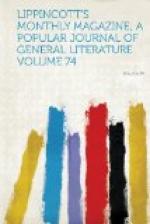“Although one of the most celebrated violin-makers that ever lived, this peasant always remained poor. It is true that one grand duke favored him, but then his patron died, and whilst the emperor permitted him to be the court fiddle-maker, he was scandalized, like the rest of the world, by his reading Lutheran books, picked up in the market at Hall. These books caused him to be thrown into prison as a heretic, and although in time released, debts and poverty embittering his life, he became introverted and melancholy, until finally the humble, patient worker, who had sent forth so much melody into the world, was strapped to the wooden bench of his cottage at Absam, a heart-broken maniac. The merciful messenger Death released him after several years, but the bench and the hole in the wood by means of which he was bound may still be seen.
“When the artist was forgotten his works increased greatly in value. This occasioned other makers to endeavor to multiply their number, introducing many spurious Stainer violins, which gradually brought down the market value. Nevertheless, genuine Stainer violins are recognizable, and still retain a fancy price. Mozart possessed one which he greatly prized, using it as his solo quartette instrument. It belongs now to a professor in the Mozarteum at Salzburg, and was played upon at the Mozart festival in 1856.
“But a violin with a still more remarkable history figured during the festivities attending the marriage of the present emperor of Austria. During the visit of the emperor Charles VI., King Friedrich Wilhelm of Prussia and other princes to the great nobleman Count Wenzel von Trautmannsdorf, the generous and lavish host became sorely perplexed how to provide George Stezitzky, a splendid violinist, with a suitable instrument. At this point he opportunely heard that there was an old fiddler in the court who begged permission to play before the august company. The request being granted, the musician commenced playing, and immediately sent princes and nobles into raptures over the tones of his violin. The count therefore stopped him, and offered to buy it. This quite threw the old man into despair. ‘It was a Stainer violin,’ he replied, ‘and his whole livelihood was bound up in it.’ The count, however, was not to be thwarted: he gave him fifty ducats for the piece he had played, and then concluded the bargain on the following conditions: three hundred gulden for the violin, besides a house to live in, food and a quart of wine daily; ten gulden monthly, two barrels of beer and one suit of clothes yearly, fruit and as many hares as he needed for his kitchen. The agreement having been concluded, George Stezitzky played a solo on the violin: then received it as a present from the count. The man who had parted with it lived sixteen years more, thus costing the count in actual money 8733 florins 20 kreuzers, equal to 10,380 florins 24 kreuzers of the present currency. A large sum to give for a violin.”




